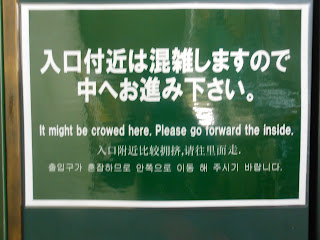I'm currently writing this on my smartphone on the floor of Cian's apartment, as he takes a nap while waiting for the water and gas people to drop by and do their thing.
I said goodbye to Kuriyama yesterday. On my last night, I decided to go for a bike ride to revisit some of the spots I'd spent the most time over the year. I started by biking over to Kuriyama High School, where I spent many a day teaching, working and doing other things. I snapped a quick photo in the dark, but it doesn't really do it justice.
Then, I biked over to Jessica's house, taking the route I always took. I thought about the movie nights, the Glee marathons. I thought about baking cookies in the microwave and the massive amount of junk food we consumed in preparation for NaNoWriMo.
Then, I headed back down the main street, to my apartment. I sat in my empty place for a while, drinking a beer and remembering the dinners I'd had with friends, the effort I put into biking home with 8 giant bags from Homac in an attempt to make it my own. I thought about the town and everything it had given me.
I finished my drink and went to sleep, ready for the next phase in my adventure. Southeast Asia, you'd best be ready for me!

























